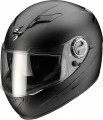Size
The sizes in which this helmet model is produced.
The appropriate helmet size depends primarily on the circumference of the wearer's head. The circumference is measured at the widest point of the head — usually at a level of 1 – 2 cm above the eyebrows and along the protrusion at the back of the head; more detailed recommendations and descriptions can be found in special sources. Here we note that although manufacturers use the same size designations —
XXS,
XS,
S,
M,
L,
XL, etc. — specific sizes for different brands may vary slightly; for example, XL can fit both 60 – 61 cm and 61 – 62 cm. This seemingly small difference can significantly affect the comfort and safety of use. Therefore, when choosing, you need to be guided by the size tables of a particular manufacturer.
It is also worth considering that helmets with the same size designation may differ not only in actual size, but also in the shape of the internal space. Therefore, even compliance with the size table is not a guarantee that the product will be suitable; the most reliable way is to test the helmet "live" before buying.
Size adjustment
The method of adjustment in size provided in the design of the helmet.
Many modern motorcycle helmets have a system that allows you to
adjust their size within a small range. This allows you to optimally adjust the product to the size of the head (which very rarely corresponds to the standard size to the millimetre), providing a snug and at the same time comfortable fit. Control systems can be:
- Swap. Adjustment in the form of a pneumatic cushion, inflated in the region of the lower part of the head. It is used in helmets of a closed design, mainly
integrals and
crosses(see "Type"), while the pillow covers, usually, almost the entire circumference of the helmet (except for the chin).
- Twisting. A mechanical system used in shallow open helmets (usually the so-called "3/4 low profile" models). It has the form of a plate on a movable mount, located in the back of the head; due to fastening, this plate is pressed against the back of the head, firmly holding the helmet on the head even when the strap is unfastened (which, however, does not eliminate the need to fasten it while riding).
Visor
The type of visor used on a helmet. A visor in this case means glass that covers the face of a motorcyclist from wind, dust, raindrops, etc., and often also from the bright sun. Note that there is a specific category of visors — sun visors; they are not taken into account in this case, for more details on such devices, see "Functions / Capabilities". Traditional visors can be as follows:
—
Transparent. Classic transparent glass that does not change the visible image. In bright sunlight, such visors are less comfortable than tinted visors, but this drawback can be compensated for by using additional sun visors (see below). At the same time, transparent glasses do not impair visibility at dusk and are generally more versatile, and therefore are used in most helmets, where visors are generally provided.
—
Toned. Visors with tinting. Usually, we are talking about a certain degree of dimming — from light "smoky" to almost black or mirror (glasses tinted in yellow or orange have their own specifics, so they are indicated separately — see below). Tinted visor improves visibility in bright sunlight; in addition, it is often made polarized, which also reduces the amount of visible reflections (from water, from shiny metal surfaces, etc.). On the other hand, through such glass it is worse to see in the evening and at night than through transparent glass — up to the complete impossibility of us
...ing a helmet with a closed "visor" normally. So tinted visors are recommended to be used exclusively for daytime driving.
— Tinted/transparent. This option is indicated for models available in different configurations — both with tinted and with a transparent visor. This allows you to choose the option of your choice, depending on personal preferences and the expected characteristics of the ride. And some models can be equipped with glasses of both types, which makes the helmet universal right out of the box.
— Yellow. Visor tinted yellow or orange. These lenses are sort of the opposite of tinted visors: the yellow tint enhances image brightness and contrast, improving visibility in low light, from cloudy weather to driving in the evening and at night. But in daylight, even not very bright, the yellow colour can cause discomfort (although it all depends on the user's preferences). In general, this is a rather specific category, it is rarely installed in standard helmets: it is believed that the need for yellow glass rarely arises, and if it does arise, such a visor can be purchased separately without any problems.
— Is absent. Visors, by definition, do not have cross-country helmets designed for use with glasses; in addition, glass is missing in some open models (see "Type"), in which such equipment does not fit due to construction or design reasons. But in other types of helmets, this option is practically not found: if this model allows the installation of a visor, it is almost certainly equipped with at least the simplest transparent glass.
